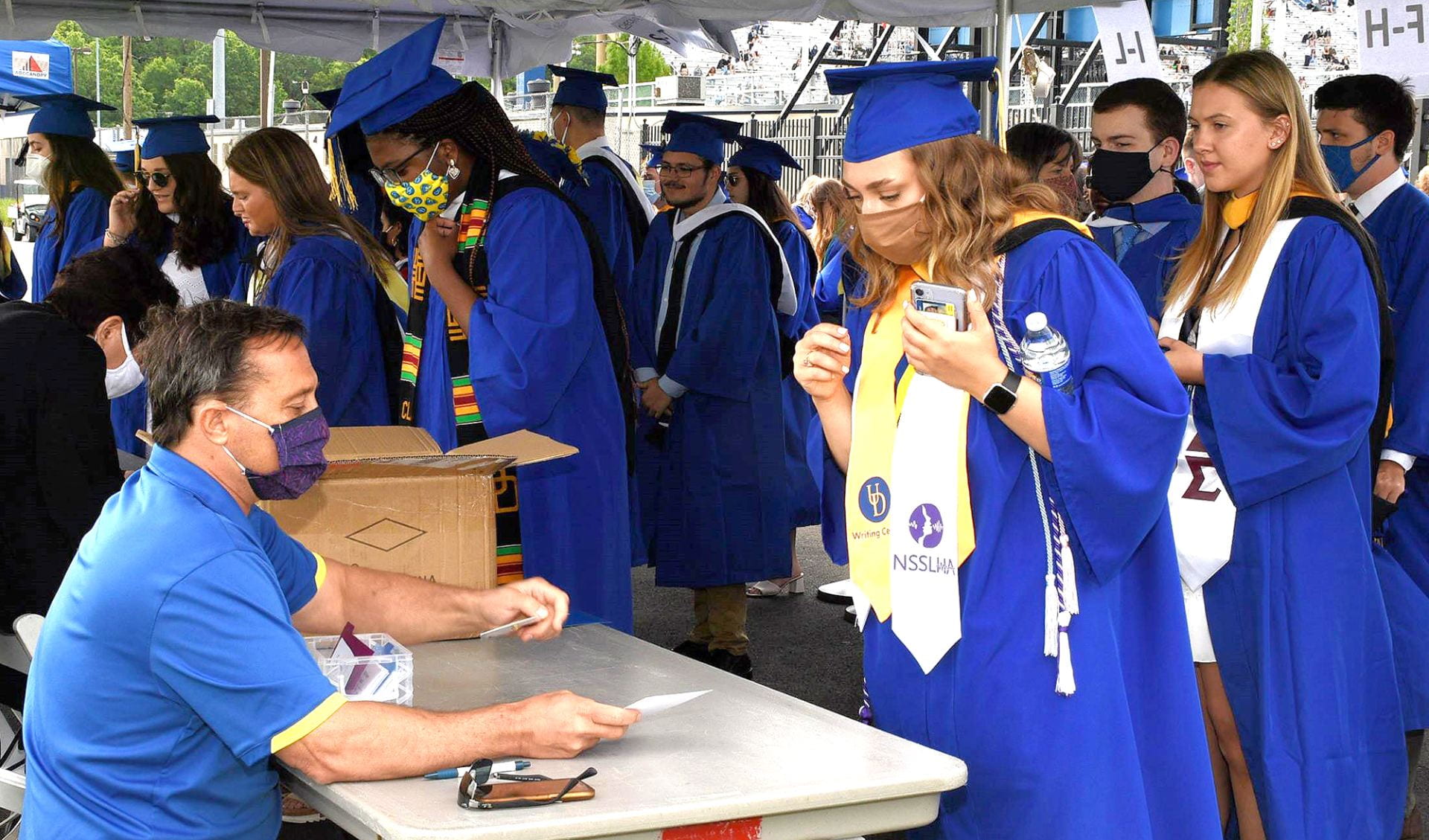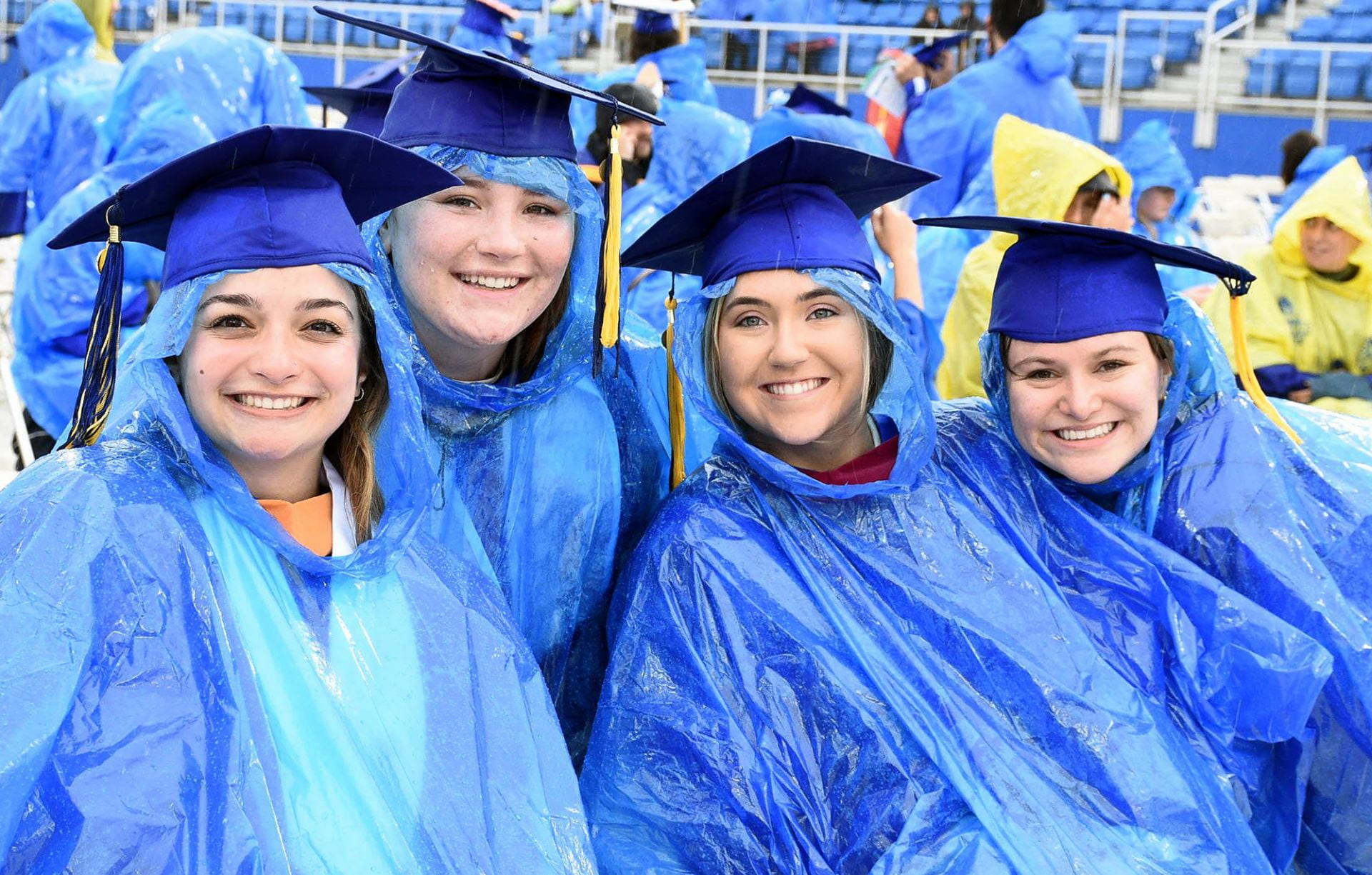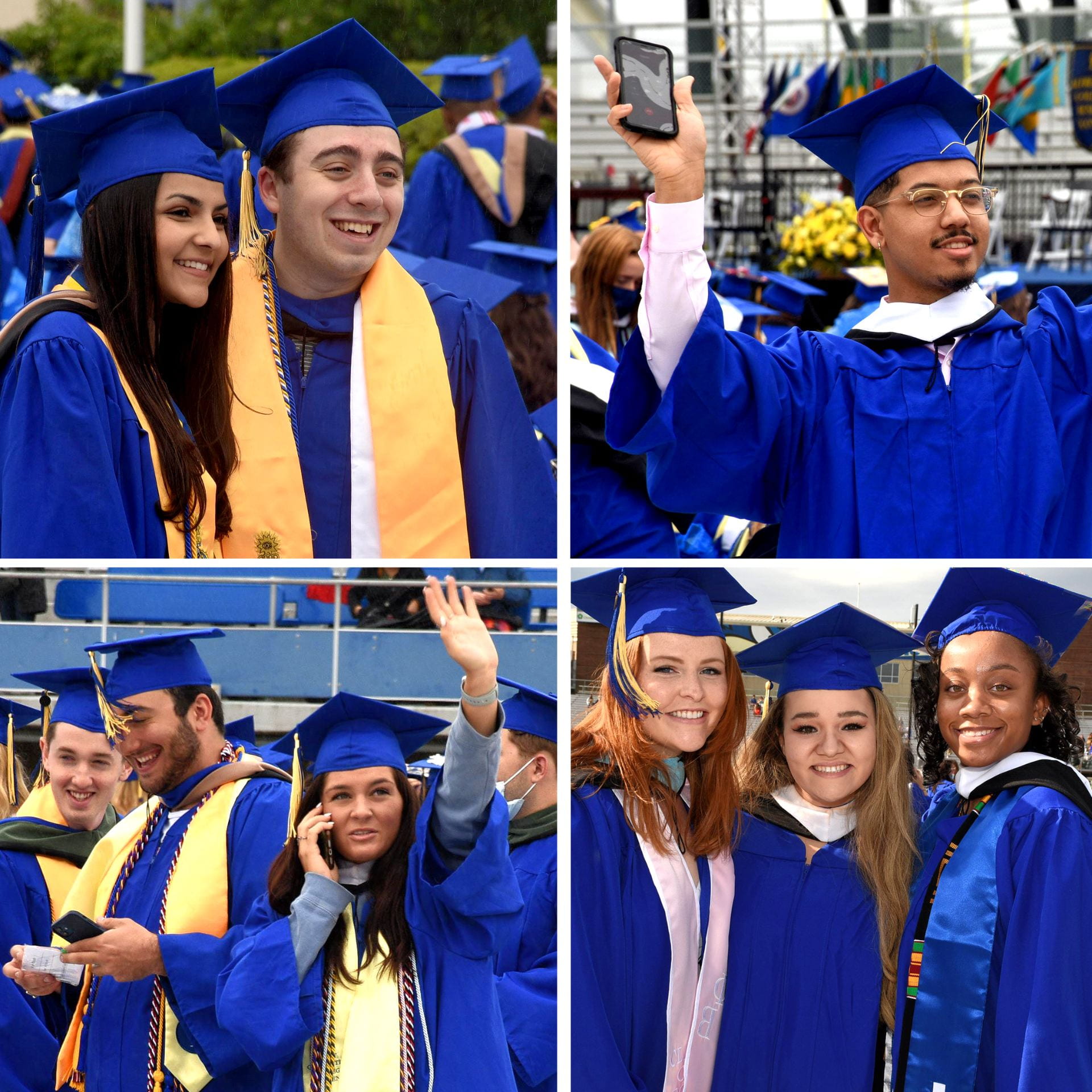How We Kept Graduation Traditions Alive In An Untraditional Year

Note: This story was written during the COVID-19 pandemic. None of the content has been changed so that it reflects the sentiments of the moment.
The UD Conference Services Team reflects on planning and implementing six graduation ceremonies during a pandemic.
When we think about graduation, we think of tradition. Large crowds made up of families, the graduating class united in one place, inspirational keynote speakers, convocations where students cross the stage to receive their diplomas while their name is announced to the cheers from family and friends, and the post-ceremony lingering filled with hugs and photos. It’s a long-awaited, proud moment for students, their families, and the University.
These traditions were put to the test for the 2021 Commencement ceremonies.
Polly Weir, Director of Conference Services, along with Lea Asti, Commencement Manager, and Sarah Janus, Event Manager, gathered to reflect on the challenges and triumphs of pulling off six commencement ceremonies and dozens of virtual convocations during a pandemic.
December 2020: Planning Begins
Knowing that what students and families wanted most was in-person graduation, key departments (UDPD, Cleaning, Security) gathered with Conference Services to discuss what was possible given the safety guidelines established by the Governor’s Office and the University protocols at the time. Can it be done? As Lea Asti points out, “Research needed to be done upfront, including watching hours of videos of how other universities, and even high schools, handled their commencements – virtual and in-person – and the PR surrounding their events.”
Eventually, a framework was created: Commencement ceremonies would become six outdoor, in-person ceremonies, rain or shine, over a 4-day period with 2 guests allotted for each student. Convocations would go virtual. This was deemed the safest option for social distancing. “We knew there would be hurdles – from potentially changing guidelines to things we hadn’t even thought of yet – but we had a clear direction and we committed to not moving anything inside,” says Lea Asti, who spearheaded the entire event. “We stayed conservative so that no matter if things got worse or better, we always felt comfortable with our plan.”
Some protocols remained. Masks were required and everyone attending had to submit to a health survey. Capacity restrictions were enforced from the stands to the lavatories. Social distancing continued.
It was important to accept early on in the planning process that there was no right way to do this. We were planning live events with thousands of people during a pandemic. We decided our plan was in the best interest of all the students and parents and that’s what we would execute.
-Lea Asti
Convocations Go Virtual, but a New Tradition is Born
Typically, in the days surrounding Commencement, each college gathers together for a more intimate ceremony – the moment of elation where students walk across a stage and receive their diplomas while their name is announced as family and friends cheer and applaud. These Convocations–more than 40– happen all around campus. Not this year.
Sarah Janus, Event Manager, took on the challenge of finding a way to keep this tradition alive. “Sarah was extremely valuable. She worked previously in the University Secretary’s office where she coordinated Commencement before Conference Services took it over,” explains Polly.
Forced to reinvent the traditional convocation processes due to COVID safety protocols, budget restraints, and enforced staff reductions, she found the answer with StageClip – personalized video experiences for each graduate. “Plus,” Sarah adds, “for anyone who didn’t feel comfortable going to the in-person ceremonies, or couldn’t travel, this was a great backup option.”
Turns out, almost every department elected to do the virtual convocations. Department chairs and Deans were able to address students virtually and, explained Sarah, “Each student could create individualized content. Along with their name and degree, students uploaded a photograph, a message, or a video of themselves thanking someone. In the end, students experienced ‘hearing their name’ as they were individually recognized, and their message was incorporated. What made this program cool is that students received their video clip as a keepsake – so it’s something they will have forever.”
Commencement: Check-in. Seat. Repeat.
Getting Commencement to run smoothly one time is an incredible accomplishment. The Conference Services team made it happen six times. Critical to the success was managing the collaboration between so many departments: University Secretary’s Office, Athletics, Media Services, IT, Facilities, Custodial, Dining, Shops, UDPD, Environmental Health and Safety, Security, to name a few. In addition were integral players like the production company Light Action, and a dedicated group of volunteers.
Volunteers were tasked with checking in and seating 800-1200 students in an hour and a half, checking the health surveys required for anyone attending, checking in and directing parents to their seats, assisting in timing the students onto the stage, and assisting in the Robing Room. Each ceremony brought a new group of volunteers, and each group needed to be trained. Even though hour-long training sessions were conducted days before Commencement, there was so much ground to cover that smaller sessions were necessary for each group. That repetition took a lot of time…but it paid off. Just before one of the ceremonies, the weather turned to rain and wind. Pivoting volunteers to indoor check-in, handing out 9,000 ponchos, and putting the student name cards into Ziploc bags to keep them dry was the result of training and collaboration that, by this time, had become second nature to the Conference Services Team.
Another challenge awaited: Once the decision was made to hold Convocations virtually, students walking across the stage shifted to the commencement ceremonies – requiring some untraditional thinking. It soon became clear that technology was needed to pull this off in under two hours…six times. It was decided to partner with a software vendor to assist. MarchingOrder was the chosen product because it was being used at peer institutions.
MarchingOrder enables the precise pronunciation and syncing of names and degrees to a jumbotron while the student walks across the stage. It takes the human element, and its potential error, out of the equation which can be helpful when timing is critical. Still, there were plenty of concerns: A new technology had to be learned quickly and as with so many electronic components came potential snafus all along the way. Plus, as Sarah noted, “Getting student graduate information is not the easy process that we thought it would be – and it impacted everything from virtual convocations to ticketing. There’s a continuous back and forth process between students submitting updated information to the Registrar’s Office and the Registrar disseminating it out to us and the different departments. Making sure that we had the correct diploma names, the correct degree titles, etc., was a huge group effort amongst our teams and the different departments and colleges.”
From the Littlest Things to Big Surprises
There wasn’t a single aspect of the ceremonies that didn’t get impacted in some way. Keynote speakers were replaced with a video of President Biden. Commencement program booklets became digital downloads. Graduation pins, typically placed on every chair, had to be picked up at a central location.
Ticketing this year was logistically challenging. Students were allowed only two guests so tickets were sold in pods of two in order to honor social distancing guidelines. This exposed a host of unforeseen issues for families dealing with divorce, extended families, and different households.
Something as simple as making water and cups available became chilled bottled water in anticipation of 90-degree weather. But that quickly changed because the weather changed. “We thought we’d be wearing sundresses and sandals,” Polly chuckled. “Instead, we’re wearing hiking boots, winter jackets, and ski hats.” Sarah smiles and adds, “There’s only so many things that you can anticipate. But when I just start expecting that anything could happen, that’s when nothing surprised me. By the end I was like: Why not? Throw on a torrential downpour. 30 mile-an-hour winds – why not? You pivot from offering ice-cold water bottles to ‘Here, have a poncho.’”
Someone used the analogy that it’s like building an airplane as it’s flying through the air. When you’re doing something that’s never been done before, you don’t always know the right questions to ask, so you’re connecting the dots as you go. -Lea and Sarah
Quick Decisions: It Took a Team
“Conference Services was looked to as the point person–the decision-maker–and that carried a lot of stress,” noted Polly. Some obstacles were apparent, like staff layoffs which definitely affected the planning and execution of the event. Key people and information were no longer available and the Conference Services team had to step into those roles. Yet, with still so many players in the mix, one common thread that helped promote collaboration was that this was new to everyone. Many decisions had to be made at the moment. Whether it was ending a ceremony early because of surrounding thunderstorms, last-minute requests for student open mic, protecting student name cards from rain, handing out rain ponchos, or wiping down the temporary platform to reduce potential slips – input from various people’s expertise and experience was heavily relied upon. As Sarah reflected, “Knowing that you have a team of people giving you their expert opinions and being able to weigh their advice made it easier to present informed options to UD leadership who also needed to have a say. It was in these moments the team shined – and was a relief knowing it was not always just on your shoulders.”
Photo 1) l to r: Sarah Janis, Jeff Kuhn, and Lea Asti take it all in stride. Photo 2) l to r: Rusty Gibbs, Kyle Martin, and Carl Asti working out their next move. Photo 3) Pivoting to indoor check-in. Photo 4) Staying on top of the weather.
Biggest Challenges
One would assume that the pandemic was the biggest challenge facing the Conference Services team. It certainly had an impact, but in the end, it was communication. Trying to plan such an important event while decision-making was constantly in flux due to the changing nature of restrictions and concerns made it difficult to keep people up-to-date. Lea noted, “There was a push to get information out there because people need to plan. Flights and hotel rooms needed to be booked. People’s emotions and expectations were running high – not just with parents and graduates – but within our own UD departments. Attempting to guide people through the process while decision-making is delayed because everyone is waiting to see where the pandemic is going was tough. A single source of information for UD staff to refer to – like a dedicated landing page – will be part of the future plans. It’s that important.”
“The customer service experience was more challenging than usual,” adds Sarah. “For many families, they come when they drop their kids off, and not again until commencement. Things were in such a state of transition because of the pandemic, plus you’re dealing with a wide range of people’s comfort levels. Wanting them to have a really great experience when they come back is important.”
We always want people to have a great experience when they’re coming onto campus – especially commencement. Making sure that guests feel comfortable and safe throughout the process was a challenge, but that’s what our Conference Services team does and I think we did a good job. -Sarah
Rewarding Moments
Along with the Class of 2021 ceremonies, the four-day event culminated with a ceremony for the Class of 2020, whose commencement last year was entirely virtual. More than 1000 graduates returned to walk across the stage. “That was probably one of the most joyous ceremonies and a great close to the weekend,” Polly begins. “I can’t tell you how proud I am of the team. Always thinking creatively and fast on their feet. Always willing to take on a challenge with a positive attitude. Lea and Sarah were the ones that carried the load of the planning and the execution. Two additional Conference Services team members, Colleen and Andy, stepped in selflessly wherever they could. I knew we could do it. I’m just very, very proud of them all.”
For Lea, a collective sigh of relief came after the success of the College of Arts and Sciences Commencement which helped set a positive outlook for the remaining ceremonies. “I was so smug after the College of Arts and Sciences ceremony,” she says, “because that was the most challenging. It was the first ceremony…along with being the biggest and hardest one to produce. We were like – Awesome! We can do this.”
Sarah adds, “What was so remarkable about this commencement is that while normal tried and true traditions were going out the window, I was watching two different perspectives – people who were new to planning commencement and people who have been doing it the same way for decades – get married together to come up with a brand new format. As Lea said, we started from the perspective that we might not make everyone happy, but it’s the safest plan while still giving people options to be able to celebrate how they want to. I really learned so much from this process – especially watching Lea take everything in stride. Thankfully the University transitioned this over to Conference Services and I think that she was the right person for this job. Our team as a whole works very well together, but with Lea and Polly’s leadership – I don’t think it would have worked any other way.”
Big or small, we get it right. If you’re planning a meeting or event, Contact a member of our Conference Services team today.






